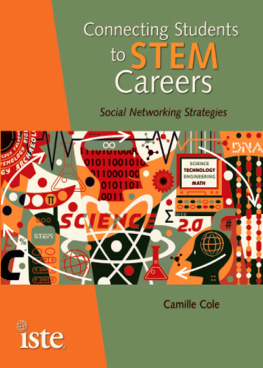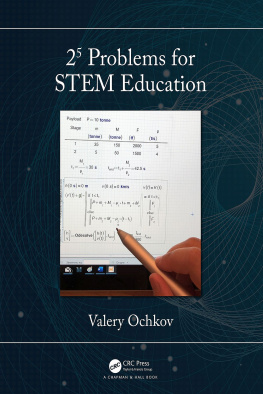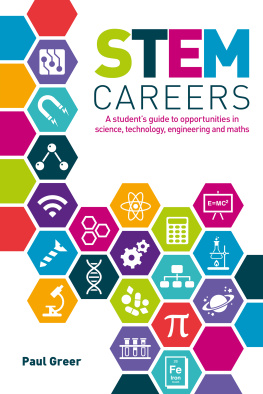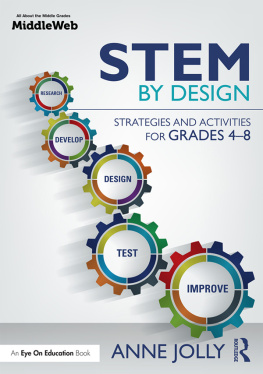Connecting Students to STEM Careers
Social Networking Strategies
Camille Cole
2011 International Society for Technology in Education
World rights reserved. No part of this book may be reproduced or transmitted in any form or by any meanselectronic, mechanical, photocopying, recording, or by any information storage or retrieval systemwithout prior written permission from the publisher. Contact Permissions Editor: ; fax: 1.541.302.3780.
Director of Book Publishing: Courtney Burkholder
Acquisitions Editor: Jeff V. Bolkan
Production Editors: Lynda Gansel, Tina Wells
Production Coordinator: Rachel Williams
Graphic Designer: Signe Landin
Copy Editor: Kristin Landon
Proofreader: Nancy Olson
Indexer: Pilar Wyman, Wyman Indexing
Cover/Book Design and Production: Kim McGovern
Library of Congress Cataloging-in-Publication Data
Cole, Camille.
Connecting students to STEM careers : social networking strategies / Camille Cole. 1st ed.
p. cm.
Includes bibliographical references and index.
ISBN 978-1-56484-291-6 (pbk.)
1. ScienceStudy and teaching. 2. TechnologyStudy and teaching. 3. ScienceVocational guidance. 4. TechnologyVocational guidance. 5. Internet in education. 6. Online social networks. I. Title.
Q197.C65 2011
507.1dc23
2011023160
First Edition
ISBN: 978-1-56484-291-6
Printed in the United States of America
Cover Image: iStockphoto.com/Russell Tate
ISTE is a registered trademark of the International Society for Technology in Education.

About ISTE
The International Society for Technology in Education (ISTE) is the trusted source for professional development, knowledge generation, advocacy, and leadership for innovation. ISTE is the premier membership association for educators and education leaders engaged in improving teaching and learning by advancing the effective use of technology in PK12 and teacher education.
Home of the National Educational Technology Standards (NETS) and ISTEs annual conference and exposition (formerly known as NECC), ISTE represents more than 100,000 professionals worldwide. We support our members with information, networking opportunities, and guidance as they face the challenge of transforming education. To find out more about these and other ISTE initiatives, visit our website at www.iste.org.
As part of our mission, ISTE Book Publishing works with experienced educators to develop and produce practical resources for classroom teachers, teacher educators, and technology leaders. Every manuscript we select for publication is carefully peer-reviewed and professionally edited. We value your feedback on this book and other ISTE products. E-mail us at .
Contact Us
Washington, DC, Office:
1710 Rhode Island Ave. NW, Suite 900, Washington, DC 20036-3132
Eugene, Oregon, Office:
180 West 8th Ave., Suite 300, Eugene, OR 97401-2916
Order Desk: 1.800.336.5191
Order Fax: 1.541.302.3778
Customer Service:
Book Publishing:
Book Sales and Marketing:
Web: www.iste.org
About the Author
Camille Cole is a thirty-year educator who has worked both in the classroom and as the coordinator of distance learning for the State of Oregon. She now works full-time as an educational program development consultant and grant writer.

During Camilles tenure as the distance learning program manager for K12 Oregon, 19982006, she oversaw the deployment and implementation of Oregons statewide videoconference network, Oregon Access Network. She has been a national leader in the K12 educational technology field for over 20 years. Camille is the president and principal researcher for Schoolhouse Communications, an e-learning and technology implementation consulting and communications group. She is an alumna of the University of Oregons School of Education.
Camille is the coauthor of Videoconferencing for K12 Classrooms, (ISTE, 2009), which is used worldwide in university classrooms, teacher training workshops, and seminars. She also writes historical non-fiction and fiction. Her work has been published in literary and professional journals. She is currently working on the educational history book The Brass Bell.
You can find out more about Camilles work at www.camillecole.com
Thanks and Recognition
Id like to thank the people who took the time from their busy schedules to be interviewed for this book: Dr. Patricia Galloway, Mowgli Holmes, Dr. Laurence Peters, Kathy Schrock, and Dr. Lynn Schrum. Also, thanks to my family for their support and encouragement. Finally, special thanks to Jay Matheson for his inspiration and support when I needed it most.
Dedication
For my parents, Peter Wilcox Cole and Ethel McPherson Cole
Introduction
This is the digital generationa generation of kids raised in a media-rich, networked world of infinite possibilities. They are learning, communicating and socializing in new and exciting ways. For them, technology is more than just a tool, its an essential component of everyday life that frames their world view. |  |
But theres more to their world than just playing with gadgets. Its about engagement, self-directed learning, creativity, and empowerment. They are hyperconnected to their friends and family, mastering new tools and techniques with ease. Behind every successful kid are adults and peers who guide, motivate, and support them. |
E DUTOPIA , T HE D IGITAL G ENERATION P ROJECT |
STEM = Science, Technology, Engineering, and Math
When the Soviets launched Sputnik in 1957, school kids waited in their backyards at night to get a glimpse of the first satellite as it blinked across a star-filled sky. The advent of the space age brought about a short-term boost in the awareness and popularity of STEM curriculum and careers. American newspaper headlines warned about the science gap between the U.S. and the U.S.S.R. STEM professionals such as Wernher von Braun, Chuck Yeager, John Glenn, and even NASA staffers became pop culture icons. STEMs place in education and culture seemed to be assured.
Unfortunately, as with most things, the media attention eventually died down. Ironically, in todays world, although there are more possibilities for STEM careers, more need for them, and more choices in them than ever before, the percentage of students pursuing STEM-related degrees has declined.
Increasing student interest in STEM is a high priority for schools. It has been identified as a focus by most prominent educational systems worldwide. Although making STEM a priority is a strong first step, without strategies for making these curriculum areas interesting and attractive to students, STEM initiatives are doomed to fail.
















